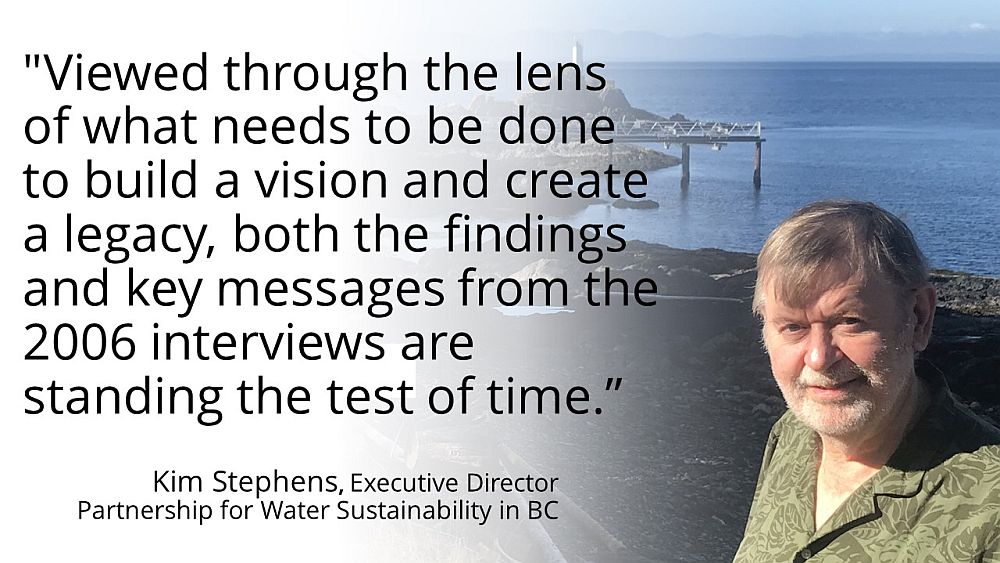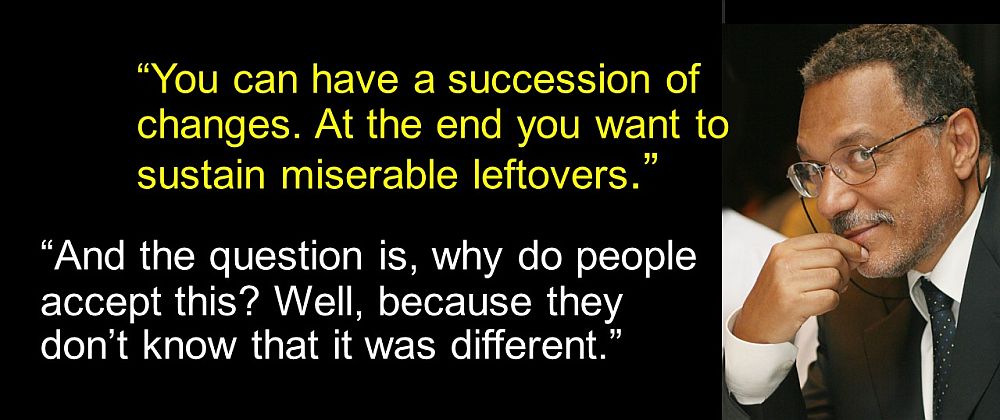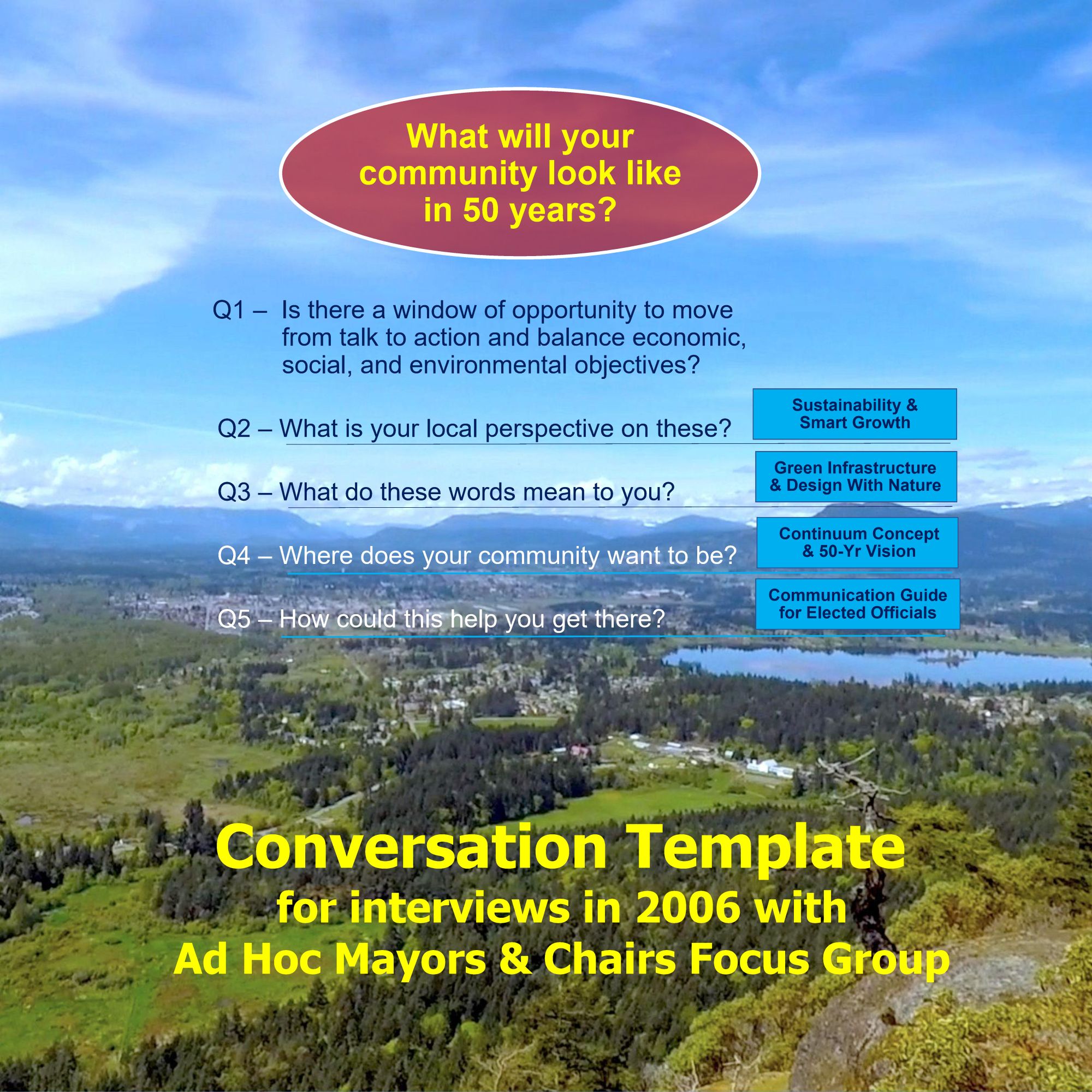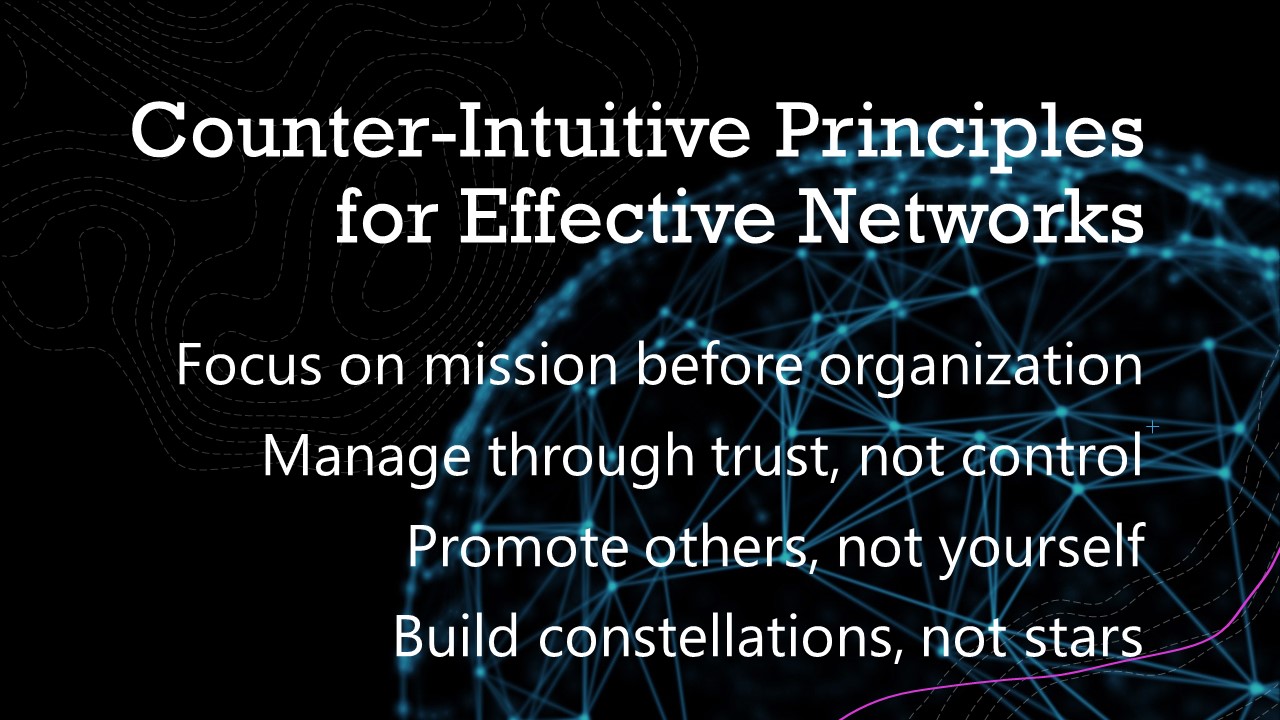FLASHBACK TO 2006 / MAYORS & CHAIRS FOCUS GROUP FOR GREEN INFRASTRUCTURE: “Viewed through the lens of what needs to be done to build a vision and create a legacy, both the findings and key messages from the 2006 interviews are standing the test of time,” stated Kim Stephens, author and Executive Director, Partnership for Water Sustainability in British Columbia (September 2022)
Note to Reader:
Waterbucket eNews celebrates the leadership of individuals and organizations who are guided by the Living Water Smart in British Columbia vision. Storylines accommodate a range of reader attention spans. In September 2022, the month before local government election day in British Columbia, the Partnership for Water Sustainability featured a flashback story about a report published in 2006.
The story behind the story is that following the BC local government elections in November 2005, the Partnership brought together an inter-regional focus group of mayors and chairs to help the Partnership frame concerns, issues and outcomes for sustainability and adaptability. By providing historical context, this flashback provides a frame of reference for judging progress over the past two decades.
To Download a Copy:
Click on this link: “Living Water Smart in British Columbia: Communities in Balance with Water – Create a Vision, Build a Legacy” .

Look back and take stock: How well are we doing? Now what?
Every generation is handed a world that has been shaped by their predecessors – and then seemingly forgets that fact. In a short-but-influential paper published in 1995, legendary UBC fisheries scientist Daniel Pauly argued that this blind spot meant scientists were failing to account fully for the slow creep of disappearing species.
Daniel Pauly coined this effect as the Shifting Baseline Syndrome. Since then, the shifting baseline effect has been observed far more widely than the fisheries community – it takes place in any realm of society where a baseline creeps imperceptibly over generations.
“The loss of historical depth” is the main cause behind the syndrome, stated the German sociologist Dietmar Rost in his book about Daniel Pauly’s concept. Their observations provide context for the following flashback to 2006 which launches a new season of Waterbucket eNews.

Communities in Balance with Water
At the turn of the 21st century, British Columbia was in the midst of a development boom. This followed the “lost decade” of the 1980s when economic activity in the province virtually ground to a halt. Population growth and climate change were issues in the 2005 local government elections.
In the months immediately following the election, the Partnership interviewed an inter-regional group of mayors and chairs representing the Okanagan, Metro Vancouver and Vancouver Island. A distinguishing feature of the focus group was that everyone had thought about how to achieve environmental, economic and social objectives through a community’s infrastructure choices.
We unveiled our findings in November 2006 at the Building SustainAble Communities Conference held in Kelowna. A month before local government election day in October, the Partnership brought forward the 2006 report so that our many readers who are elected representatives would have a frame-of-reference for pondering this question:
When you reflect upon what local government leaders knew in 2006, how do you judge your community’s progress on its green infrastructure and water sustainability journey?


EDITOR’S PERSPECTIVE
“Embrace the intergenerational baton and build on the knowledge and experience of those who went before you. Be inspired by oral history. Most importantly, understand the context. Stay in touch with the past, as Daniel Pauly urges, while continuing to move forward,” stated Kim Stephens, Waterbucket eNews Editor and Partnership Executive Director.
“A generation ago, in mid-2005, the Partnership decided to write a Communication Guide for Elected Officials that would help them turn ideas into action. The mission, achieve a vision for settlement, economy and ecology in balance. We saw the Guide filling a gap, because it would be written from the perspective of elected officials, for elected officials.”
“Following the local government elections in November 2005, the inter-regional group of mayors and chairs helped the Partnership frame concerns, issues and outcomes for sustainability and adaptability. The process gave a huge boost to collaboration and alignment, both within and between regions.”

Communities in Balance with Water: Key messages from 2006 are timeless!
“The one-on-one interviews yielded consistent insights.,” continued Kim Stephens. “A unifying theme was the issue of leading and implementing change; also, emphasis was placed on the importance of mobilizing political will to achieve settlement, economy and ecology in balance. Key messages as synthesized in the Partnership’s 2006 summary report are:
- Time is of the essence.
- To create a legacy, there must first be a shared vision.
- Trumpet small successes.
- Encourage innovation.
- Federal/provincial infrastructure programs will ultimately drive changes to infrastructure standards and practices.
- Leaders can create the ‘buzz’, the interest and the energy to imagine what the future could look like and then make it happen.
- The position of mayor provides a leader with the credibility and authority necessary to translate a community vision into action.
- Mayoral collaboration will be a powerful force for change when there is a shared regional vision for the Built Environment.”
“What we learned was not unexpected. Rather, it was more a case of validation. Viewed through the lens of what needs to be done to build a vision and create a legacy, both the findings and key messages from the 2006 interviews are standing the test of time.”

So, what is different in 2022?
“Two decades ago, the impact of the 2003 drought and forest fires that forced the evacuation of Kelowna was game-changing. Water sustainability emerged as a provincial government priority. There was a sense of shared purpose around the urgency to align efforts, commit resources, and implement evidence-based solutions.”
“In recent years, however, so many issues have challenged local governments. Competing demands and shifting priorities have slowed their water sustainability progress. But the growth and climate concerns, issues and impacts identified in the 2006 interviews have not gone away.”
“Today, competing demands coupled with organizational amnesia are playing out in the ongoing loss of oral history. The consequences or risks of “not knowing what you don’t know” mirror what Daniel Pauly foreshadowed in the Shifting Baseline Syndrome:

Template for conversations about Communities in Balance with Water

FLASHBACK TO 2006: Story behind the story of the “conversation template” for interviewing elected officials
Language and flow are critical if a document is to help elected officials and senior managers step outside their normal view of the world. This was the frame-of-reference for interviewing the inter-regional group of local government leaders about the concept for a Communication Guide for Elected Officials.
Context for Interviews
Circa 2005, we recognized that conversations with elected officials would be an essential ingredient in developing a shared understanding of the vision for Communities in Balance with Water.
The starting point for the interviews was the premise that we can create our future, and the decisions that elected officials make today ripple through time. We pointed out that those decisions can result in either cumulative impacts or cumulative benefits.
The ‘conversation template’ (shown in the image above) guided the one-on-one interviews about settlement, economic growth, and water-centric issues. The template comprised a set of five questions that drilled down from high level to ground level. The questions were open-ended. The answers influenced the line of follow-on questions.

The Interview Process
When conducting these interviews, we outlined the frame-of-reference below to initiate the conversation:
- We understand that green infrastructure is but one of a myriad of issues that an elected official in local government must process on an ongoing basis.
- Our approach is based on “listening to” rather than “talking at”.
- We recognize that senior municipal and regional managers may only have ‘milliseconds’ to convey the essence of green infrastructure to elected officials.
- Similarly, senior managers may only have ‘minutes’ to absorb the supporting details from their technical staff.
- Therefore, choice of language is critical for effective communication, whether it be between technical staff and senior managers, or between senior managers and elected officials.
- Before we can write a Communication Guide, we need to understand what elected officials already know plus what they would like to know about green infrastructure.
- Only then can we judge what level of information transfer would be useful to them.
The insights yielded by the interviews helped the Partnership determine how we could be clear and compelling in conveying key messages.
To Learn More:
Download a PDF copy of “Living Water Smart in British Columbia: Communities in Balance with Water – Create a Vision, Build a Legacy” – released by the Partnership for Water Sustainability in September 2022. It includes, as an attachment, the document titled Water – Choosing Sustainability for Life & Livelihoods: Convening for Action in British Columbia. Released in September 2006, laid out the road map for subsequent work by the Partnership in three regions.
The one-on-one interviews opened doors such that the process gave a huge boost to “convening for action” collaboration initiatives under the umbrella of the Water Sustainability Action Plan for British Columbia. Collaboration continues to this day, guided by four principles for building effective networks:

DOWNLOAD A PDF COPY: https://waterbucket.ca/wcp/wp-content/uploads/sites/6/2022/09/PWSBC_Living-Water-Smart_build-vision-create-legacy_2022.pdf


